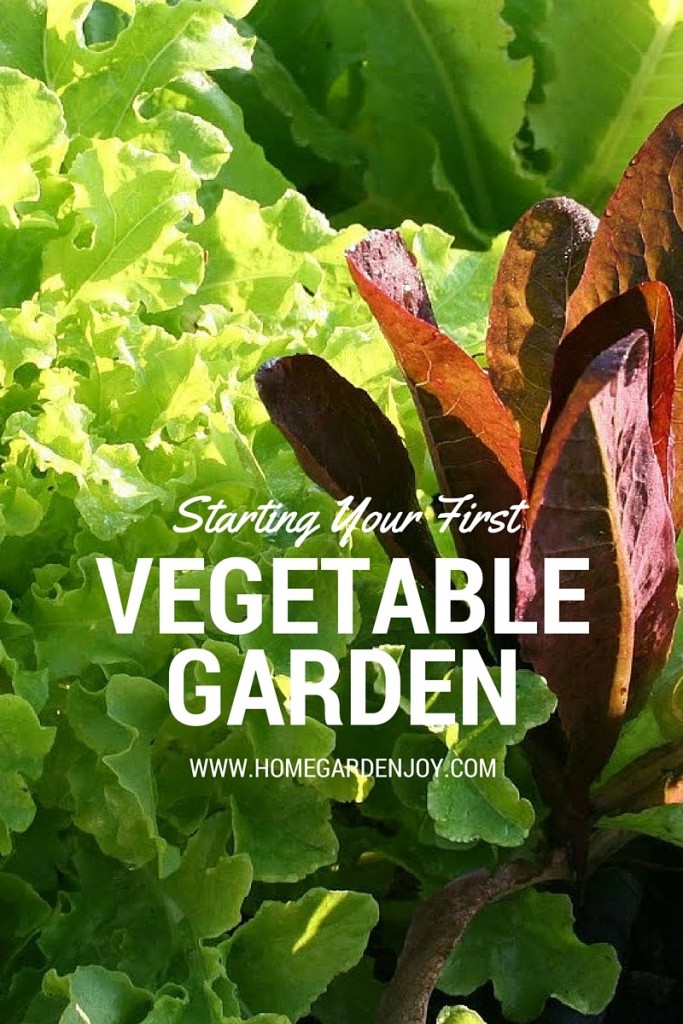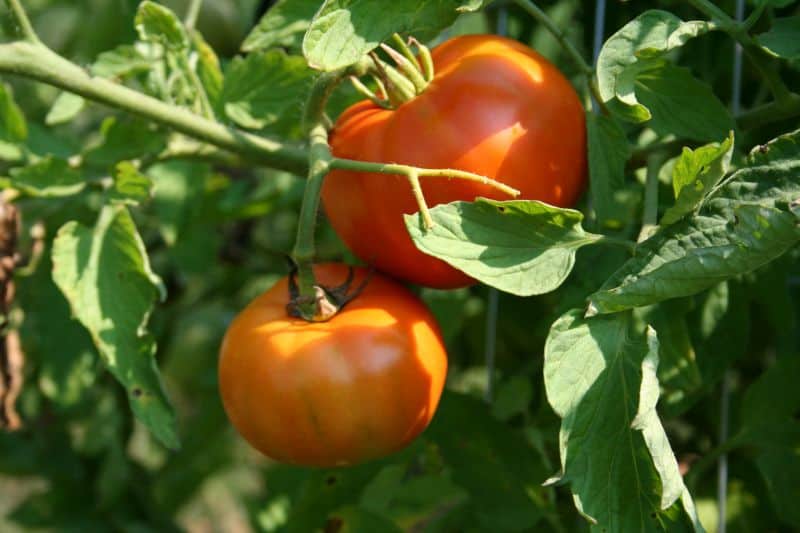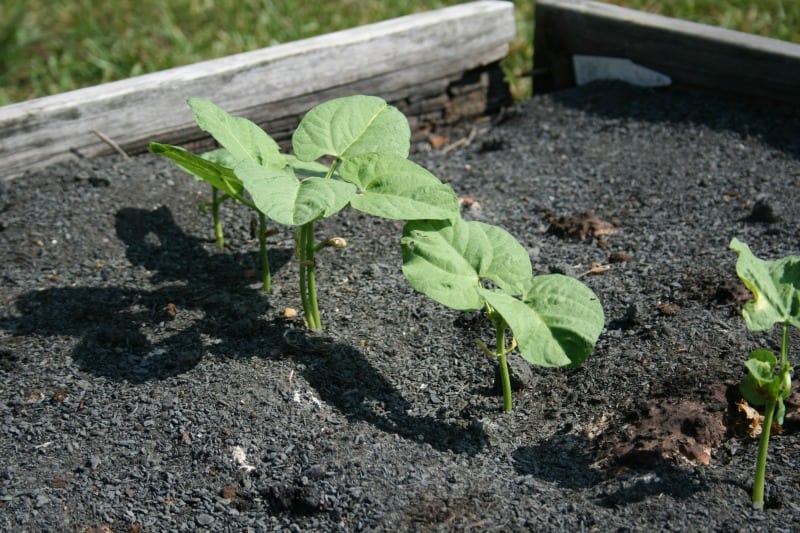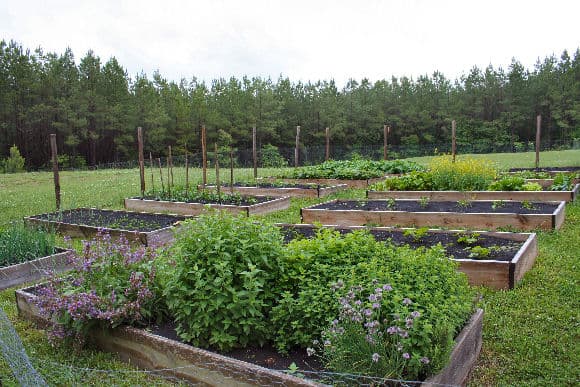If you’re new to gardening, learning how to start your first vegetable garden is a big step forward. Vegetable gardening offers you and your family a great opportunity to grow healthy, fresh vegetables right in your own backyard or on your balcony or patio. But what do you need to know to start your first vegetable garden?
The Basics of Starting Your First Vegetable Garden
No matter where you live or how small your garden space, you can grow vegetables. You’ll need four things to start with: light, soil, water and space.
Light Requirements to Grow Vegetables
Most vegetables need full sunlight to grow into healthy edible vegetables. What is full sunlight? It’s defined by gardeners as six or more hours a day of bright, direct sunlight.
Take a look at the area you’re thinking about growing vegetables in, and watch the sunshine patterns for a day or two. Keep in mind that light changes depending on the season. Deciduous trees such as maples or oaks may shade an area in June that’s normally in bright sunlight in January. The sun is higher overhead in the summer and may shine on areas shaded during the winter by fences and sheds. Use your best judgment about how much light an area receives.
All vegetable plants thrive in bright, direct sunlight. A few can grow in partial shade. Green beans, lettuce and certain herbs such as oregano can survive in partially shaded areas. To grow tomatoes, peppers, eggplant and many other common garden vegetables, which is what most new gardeners want to grow, you will need bright sunlight.
If your garden doesn’t get bright sunshine, can you find another area on your property that does? Vegetables can be grown in pots and containers. I gardened for eight years in large tubs on a sunny patio because the garden area itself was almost in complete shade throughout the day thanks to a neighbor’s massive oak trees and a huge hemlock hedge. Both kept the lawn and flower beds shady, which was nice for relaxing and playing, but not great to grow vegetables.
Fortunately, however, I had access to the patio, which was in bright sunlight all day long. I grew tomatoes, peppers, eggplant, cucumbers, and even a cantaloupe in big pots on the deck. If your garden doesn’t receive much light but you have another area that does, pots and containers may be the answer to starting your first vegetable garden.
Soil and Soil pH
Once you’ve chosen the area where you’ll plant your vegetable garden, you’ll need to have your soil tested to see whether it’s ready for vegetable plants or needs a little work. Don’t panic…you can’t fail this test!
Your local Cooperative Extension office can perform a soil test for a small fee. Some garden centers or farmer’s cooperatives offer free soil testing. Call around to find out who does soil tests in your area and what information the test provides to you.
Most soil tests examine at a minimum the soil pH. pH, if you can remember from high school chemistry, is a scale from 0 to 14 that measures the acidity or alkalinity of an item. Vegetables usually like soil that’s slightly acidic, or around 5.5 to 6.5. Some like soil a little “sweeter” or closer to neutral and a few like a little more acidic soil, but that’s the range for most vegetable plants.
Why is soil pH important? pH affects which nutrients are available in the soil to your plants. If the pH is in the correct range, your plants will have an easier time absorbing nutrients such as nitrogen, phosphorous, potash and trace elements like calcium and magnesium. These elements are held in suspension in the soil, broken down from living matter through decomposition. Bacteria, fungi, nematodes, earthworms and arthropods work hard year ’round the chomp their way through organic material among the minerals and rocks in the earth, breaking the carbon-based items into trace elements. When the pH of your soil is within an acceptable range to a plant, it can absorb nutrients through the water absorbed in the root system.
If the pH of your soil isn’t right for vegetables, the person who does the soil test can advise you on what you add to your soil and how much to add so that the soil gets to the right range. Lime, for example, raises the pH of acidic soils.
All soils benefit from something called compost. Compost is decomposed organic material. While you don’t need a compost pile first thing, they’re easy to start, and I provide directions here on how to start a compost pile.
If you can’t start a compost pile, you can purchase bags of compost at your local garden center. Worm composting is another way to create compost. You can keep a small worm bin in an apartment or small home to get great free compost. If worms freak you out, you can also buy compost, so don’t worry…it’s not essential to make your own, but it’s easy and inexpensive, so I always recommend it.
Your soil test will also tell you what kind of soil you have: clay, loam or sand. There are variations in between, but most soils fall into these categories. Vegetables can grow in any of these types of soil but like loam the best. You can add compost and peat moss to clay or sandy soil to improve it.
Vegetables Need Plenty of Water
Make sure you pick out a spot to grow vegetables that is near to a water source, such as your garden hose, or make sure that your hose can reach the vegetables. Vegetables need at least one inch of water per week, either from rain or from your garden hose.
How do you know if your garden gets enough water? A rain gauge, purchased at your local garden center and placed in the vegetable garden, is an easy and convenient way to see how much water your garden gets each week.
You can make your own rain gauge using a standard-sized tuna or cat food can. Once the cat is empty, throw away the lid. Clean the can with soap and water, then place it in the garden. It’s just about the right size to hold an inch of water. If it’s full, you’ve got an inch of rain.
Space: Containers, Raised Beds, or Grow Vegetables Directly in the Soil?
If this is your very first time planting vegetables, may I make a suggestion? (Well, you wouldn’t be reading this unless you were looking for suggestions, so…) Start your garden in a few big pots. How big is big? Think tubs. The bigger, the better.
Make sure the container has drainage holes in the bottom. If it doesn’t, drill a few. This helps extra water flow out of the container. Too much water will drown your plants just as much as too little can kill them.
Fill the container with bagged soil purchased from the garden center. The very best soil mix that I have ever used is Pro-Mix, which is available in large, 3 cubic foot bales. It’s expensive, and you can make a similar mix using less expensive soil mixed with your own compost or bagged compost such as Black Kow.
Plant one tomato, pepper or cucumber plant per tub.
That keeps things nice and simple.
If you’d like a bigger garden, planting a raised bed vegetable garden may make sense. A raised bed garden makes garden beds from wooden planks or other materials. Each bed is then filled with soil and compost. Because you are filling each bed with your own soil mix, you do not need to get the soil tested, and it should be ready for vegetable plants. Raised beds are easier to plant if you are elderly or have mobility issues; because they are up higher, you don’t have to bend down quite so far. They also provide good, solid boundaries so that you can teach small children to stay out of the garden beds while they tend to plants. Trampling on the soil around the plants pats it down which reduces the amount of air and moisture that can flow to the roots. This is called compacted soil. It’s like the soil around your house from when your home was built. The machinery and heavy equipment pushes the soil particles together and makes it harder for the plant’s roots to push through. When you walk upon your garden beds, you compact the soil. Raised beds create clear boundaries for children so that they don’t walk on the soil. They also make it easy for you to tend the plants.
I’ve written and published a short, inexpensive book about planning and building raised bed vegetable gardens. It is available on Amazon in both print and Kindle formats as well as in PDF format and other ebook reader formats on Smashwords.
Getting Started: Know When to Plant
You can’t plant your garden until the “frost-free” date for your region. That is the average date of the last frost each year. For most of the United States, Mother’s Day is a safe date in which you can put your plants outside, but do check the USDA Hardiness Map to figure out when you can plant your vegetables.
Some vegetables, such as lettuce, radishes, and spinach prefer cool weather. These can be planted in the spring.
Other vegetables, like tomatoes, peppers, eggplant and green beans like hot weather, so you can’t plant them outside until the warm weather arrives, the soil warms up, and there’s no more freezing temperatures in the forecast.
A great resource to figure out when to plant and what to plant is your local Cooperative Extension office. Each county has an office, staffed by both paid horticulturists and Master Gardeners. Master Gardeners are volunteers who have completed over a year’s worth of training, continuing education and more. I’m a certified Extension Virginia Master Gardener volunteer right here in Prince Edward County, Virginia. Master Gardener can guide and educate you on what to plant, when to plant it, and how to plant it.
Speaking of what to plant, one word of advice: grow only what you eat. Even if a vegetable is easy to grow, if your kids hate it, your husband won’t touch it or you hate it, give it a pass. Otherwise, if you do grow it, you’ll end up donating it all to your local food pantry or soup kitchen, which of course isn’t a bad thing, but not what you set out to do.
More Information on Vegetable Gardening
I’ve written quite a bit about vegetable gardening both here on this blog and for Virginia Gardener magazine, where I am also the Ask the Expert columnist. Below are links to many vegetable gardening articles available on this blog. Feel free to leave me a comment and let me know if you’ve tried your hand at vegetable gardening this year.
- Winter Vegetable Gardening
- How to Know When to Plant Vegetables
- A Beginner’s Guide to Growing Vegetables from Seeds











oh, I wish for the spring. I’m currently looking at a snowy blustery day and this topic sure came at the right time. I can almost smell the spring air
Great post! And your garden is gorgeous! I don’t have as much room as you, so my “experimental planting”, I call it, is about the size of one of your raised beds.
I’m blessed with a lot of land now, but I grew up in the New York City area, and learned to garden in a small area like you described. You can grow a lot with just one raised bed or even one pot or container. Thanks for stopping by!
A garden is top on my list once we get settled into our new house later this year. A large container garden as you have, would be ideal. We had a great little grower space in the suburbs once, primarily because the sunlight was just right. But our efforts in the last two years haven’t been as fruitful. Here’s to maybe success for me in 2017!
Thanks for stopping by! Maybe you can find some containers? If you’ve got a little sunlight, you can plant something, even a flower. Good luck!
This is such helpful information for an aspiring gardener like myself! I’m bookmarking this. Thanks!
Head slap! I knew your name sounded familiar, I have your book on my Kindle! This is going to be the year my veggie garden is going to produce! (I hope it is listening!)
Lots of cherry tomatoes last year, but many of my other plants did NOTHING. 🙁
Looking forward to hosting with you on the #HomeMattersParty
LOL! Audrey, you made me laugh. I am so pleased that you downloaded my book and I hope you enjoy it. Let me know if you have any questions and yes – let’s have fun with the #HomeMattersParty !
Such great tips!! Here in the mountains, I can’t plant until late April, so planning is crucial!! #HomeMattersParty
Thanks for the great information. It comes at the perfect time to start planning for a spring garden. Thanks for sharing with the #HomeMattersParty 🙂
~Lorelai
Life With Lorelai
Thanks for sharing these ideas! I cannot wait until it gets warm enough to start my garden this year! #HomeMattersParty
I have started my own garden … what is the right soil to get nurtrients to my plants
Hi Lauren, the right soil depends on the plants. Each plant has its own unique needs. If you are in the United States, contact your local Cooperative Extension (do a Google search to find it). Then, ask them how to get a soil test done. With the soil test, they will tell you what you need to add to the soil for specific plants. A rose bush needs different soil than a lawn or an asparagus bed, for example, so it really depends on what you want to grow, where you live, and what your soil is like to start out with. That is why I think it is best to ask locally at the Cooperative Extension near where you live.Good luck.